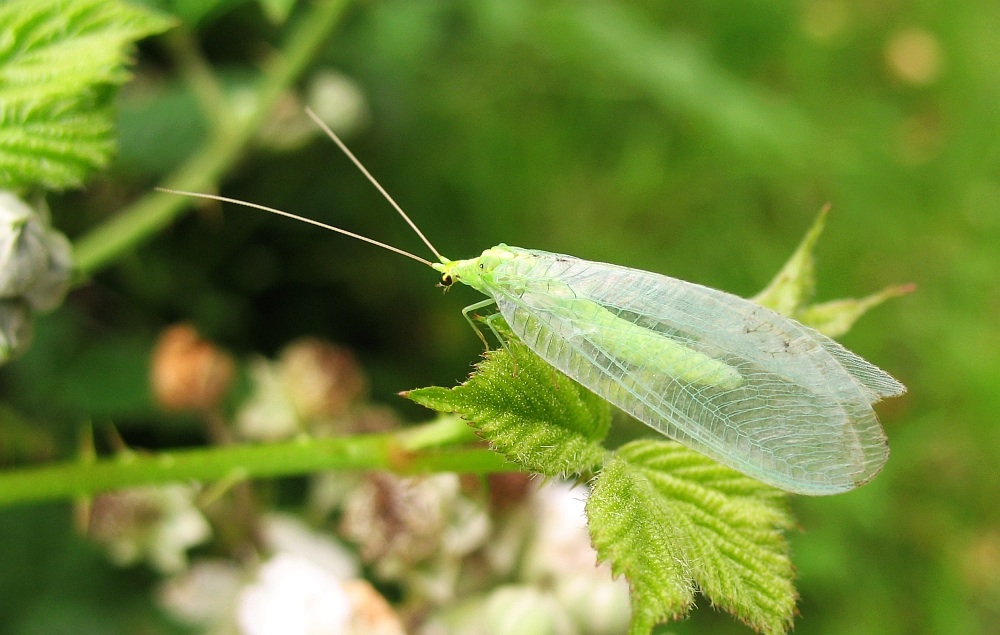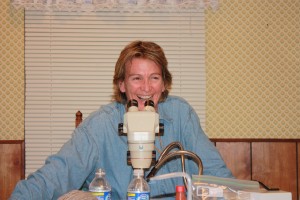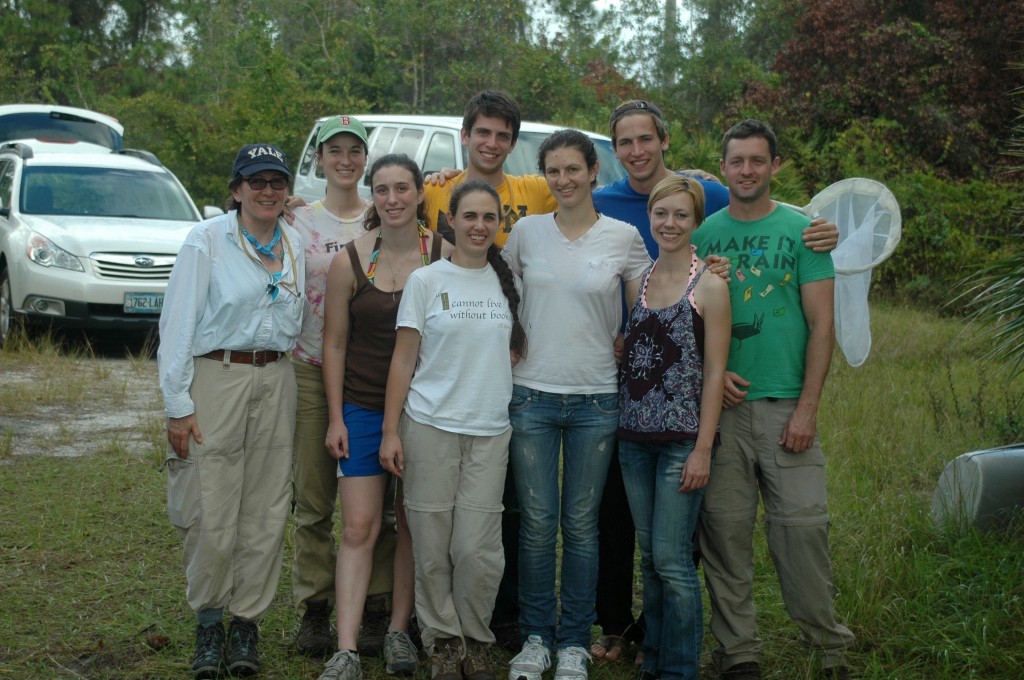
The winged insect that perches in silhouette just below Marta Wells’ collarbone looks almost exactly like a lacewing. Almost, because when she got the tattoo as a 40th birthday present to herself—and as a celebration of nearly two decades of insect research—the artist drew the antenna wrong, bulging on the ends like on a butterfly. The curling lines that peek out above her jacket, according to Wells, serve as an omnipresent reminder of the importance of distinguishing between species.
Wells’ career is based on minute details such as these: her research on the subtleties of insect behavior has revealed dozens of new species where previously scientists only saw one.
On this Wednesday afternoon, Wells is giving an anatomy lesson to her students, who are spread out across the back room of Yale’s Osborne Memorial Lab pinning, mounting and, in some cases, gutting insects. Wells is supervising two students in the corner, who are pulling out the ropey intestines of a pair of katydids they found in their bathroom. A student carrying a bucket of dragonflies preserved in acetone interrupts, asking for a pair of tweezers. Wells turns towards the student. She shakes her head and grasps the bucket by the sides. She shoves her own hand straight into the sickly yellow solution. Her hand emerges, holding the dripping dragonfly. “What we will do is cook him,” she says, firmly squeezing the body and nodding towards the small drying oven in the back of the room. “We cannot pin him until he is dry and cooked.”
Holding the dragonfly seems to remind her of something, and she quickly turns around to face the class. “Everyone, we need ants!” she says. “The dragonflies”—the class has been keeping live dragonflies in addition to the swampy bucket of bygone ones—“are going to starve if we don’t feed them. So if you see any on the ground” —she mimes scooping up an ant in her hands—“pick them up and bring them to here.” She returns to the first, lifeless dragonfly, peering through large black-framed glasses as she peels apart the diaphanous wings.
Despite her tenderness for insects now, Wells has not always been an insect aficionado. “I thought I was going to be a bird person,” Wells said. She got a degree in zoology and began work at the Smithsonian Tropical Institute in Panama studying brown pelicans. In 1985, after a couple of years studying the nesting patterns of the homely pelican, Wells left her birds for to pursue her ornithology PhD in the United States.

During her first year of study at University of Connecticut, Wells met Charles Henry, an entomology professor who studied evolution in lacewings—a group of insects named for their delicately patterned, transparent wings. The chance to study the origin of species attracted Wells to Henry’s lab. “Some people fall in love with the organism and then ask questions about them,” Wells said. “I fell in love with the questions, and the green lacewings became the model system to answer them.” The miniature biological system of lacewings allowed for controlled laboratory experiments in which the behavior of the insects, unlike the behavior of the birds she had spent years observing, could be modified.
Once she joined the Henry lab, Wells quickly displayed a knack for designing experiments. “From the beginning, she had a better sense than I did of how to design experiments to get an answer,” Henry said. And that was fortunate—she and Henry were about to identify a powerful question centered around the inscrutable mating rituals of the lacewings.
Animals that can mate with each other are considered members of the same species. In some cases, this term takes on different nuances; some scientists define species based on geographic boundaries that prevent mating between groups, for example, and others define it based on most recent common ancestors. In the case of lacewings, though, both of these definitions fall flat.
Some of the lacewings mated readily with each other, but others were hard to persuade. “You can hardly even get them to mate, even when you put them in a small cup together for a week,” Henry said. There was some marker—something that differentiated the lacewings enough to prevent mating— that the entomologists were missing.
Henry eventually noticed it: a tiny vibration in the abdomen of a lacewing that was seeking a mate. Lacewings can vibrate their abdomens to shake leaves and stems at a specific frequency. “Most people can hardly see that their little abdomens are bouncing up and down,” Henry said. After discovering that the lacewings in his lab produced vibrations that varied both in rhythm and frequency, and sounded like everything from a snare drum to a dripping faucet, Henry wanted to see if these songs had anything to do with the strange specificity with which lacewings chose their mates.
While Henry pondered, Wells pulled out her Elmer’s glue. She constructed a simple apparatus using a small recorder, a roll of Saran Wrap, and a paper coffee cup that transmits vibrations while holding the insects. Using this setup, Wells and Henry can send pre-recorded mating songs through the cup and test whether the lacewing inside will vibrate its abdomen in response—a signal that it’s willing to mate. Wells and Henry have found that if the song is similar enough to the lacewing’s normal mating song, then the lacewing will respond. If the frequency or rhythm changes—if the pulses are off by even a fraction of a second, for example—the lacewing ignores it and refuses to mate. These results suggested to Henry and Wells that the songs were essential to successful mating. This conclusion offered answers, but also more questions. Wells and Henry were essentially suggesting that the word “species” could be characterized by something as transient as the shivering of a leaf.
Wells and Henry have since identified 21 potentially new species from this jumble of look-alike lacewings. Although the vibrations themselves only last a few seconds, Wells may be able to find a genetic reason to explain how these songs are passed on. In one set of experiments, Wells found that she could fool two lacewings with disparate songs into mating by pre-recording their mating songs and piping the songs into the paper cup. Using this method, she managed to create a lacewing that sings a hybrid song somewhere in between those of its mother and father. The fact that the hybrid lacewing sings a new song suggests that the ability to produce these songs is imprinted in the DNA.
Getting all that done took Wells more than the five years she needed to complete her PhD. After finishing her PhD, Wells was offered a position teaching classes at Yale, but she wanted to continue her lacewing work. She decided to do both. In 1997, she took the faculty position at Yale as a biology lecturer and started designing the class now known by its students simply as “Bugs”. Wells spends every Friday and most of her summers at UConn with her lacewings, and the rest of her time with the motley assortment of insects her students at Yale have accumulated.

Wells’ hybrid lacewing experiments provided convincing enough evidence to make continued genetic study of the lacewings worthwhile. She recently applied for funding to identify the genes responsible for song-making. Although the project will almost certainly take years of painstaking genetic analysis, combing through genes to find the magic piece that gives lacewings their voice, Wells is not dismayed. Right now, she is reconstructing the genetic profiles of different lacewing species to see if there is an evolutionary relationship between song divergence and the rise of new lacewing species. She thinks that lacewing species may not just be characterized by their mating songs, but that new species may arise as a result of small changes in the courting songs. If Wells is right, these scarcely audible songs are more than just a marker of species—they could actually drive the differentiation of species.
Undergrads enrolled in Wells’ course at Yale, “The Biology of Terrestrial Arthropods,” aren’t probing the questions of what defines a species yet, but they still have their work cut out for them. Since she requires her students to collect 90 different insect families during the semester, venturing beyond campus is essential. Student Peter Flynn has taken to carrying around a butterfly net sometimes, even when he’s not in lab. Although Wells frowns when a student tries to take her favorite mounted spiders—“you cannot have all of them,” she admonishes gently—she is generous with both her wisdom and the insects she finds. “Sometimes I just like to stand next to her when we’re out in the field, so when she catches a dragonfly she might give it to me,” Flynn said. Colleague Antonia Monteiro, who heads a Yale lab that studies butterflies, said, “Sometimes I’ll just see her gathering people in her van and going somewhere all of a sudden. She’s very enthusiastic.” Over fall break, the class travelled to Florida to diversify their insect portfolios.
Today’s lab ends an hour late, as the light through the windows begins to fade. The students have not noticed that it’s already dinnertime. Wells turns to the novice dissectors, who have wiped the stains of katydid offal on a paper towel. One of them, points to a small tangle nestled next to the intestines on the paper towel. He has found something that isn’t supposed to be there. “What did I just pull out of there? It wasn’t in the other one,” he says.
Wells peers closely at the translucent green knot, no larger than a pinhead. “Looks like you found a parasite,” she says, poking it with the tip of her finger. She nods approvingly. “That’s great. Nice catch.”